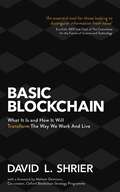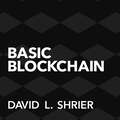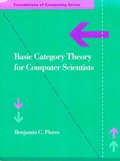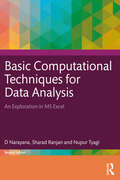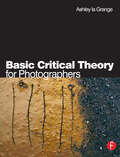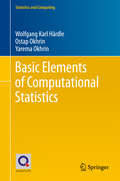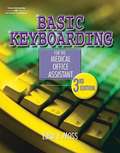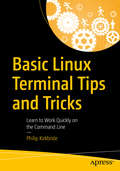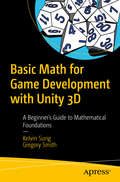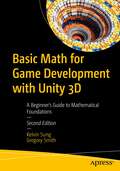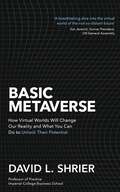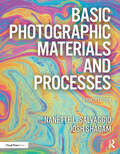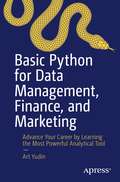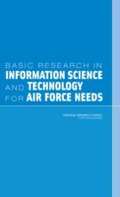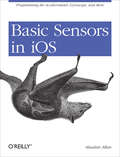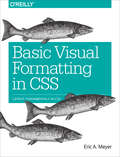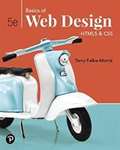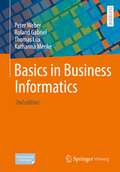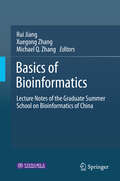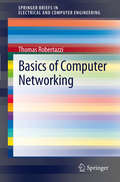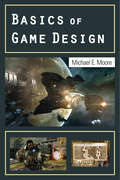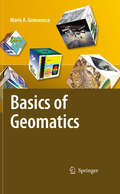- Table View
- List View
Basic Blockchain: What It Is and How It Will Transform the Way We Work and Live
by David ShrierThe only book you need to understand blockchain: what it is, how it works and how it will transform business, society and our everyday lives. Basic Blockchain is an accessible, non-technical introduction to a revolutionary technology.'Makes it easy for the average business executive to understand blockchain' -- Chris Larsen, founder and chairman, Ripple'An essential tool for those looking to distinguish information from noise' -- Eva Kaili, MEP and Chair of The Committee for the Future of Science and TechnologyA revolution is under way across the globe, yet very few people understand it. Basic Blockchain will explain everything you need to know to understand the technology that will soon disrupt and revolutionise everything from financial and health services to the property market and how we vote.Born of an obscure body of research on game theory developed by NASA, originally championed by drug dealers seeking to launder ill-gotten gains, accelerated by entrepreneurs seeking to improve financial access for the poor, funded by giant corporate interests attracted to the potential for billions of dollars of cost savings, blockchain heralds a new era of financial inclusion, legal inclusion for the dispossessed and lower prices for consumers. In short, it will enact radical change on our lives.In this book, David L. Shrier, one of MIT and Oxford University's leading futurists, explains for the general reader:- The history of blockchain, its apocryphal progenitor Satoshi Nakamoto and the socioeconomic context of its origins in the 2008 financial crisis.- How blockchain works, including the core technologies that drive it such as cryptographic hashes and network theory, all described in simple, understandable terms.- The potential of blockchain, including its impact on our jobs, industry and society as a whole. Blockchain will disrupt and transform our world in profound ways. This accessible book, written by a global authority on blockchain, is the essential introduction to the next technological revolution.
Basic Blockchain: What It Is and How It Will Transform the Way We Work and Live
by David ShrierThe only book you need to understand blockchain: what it is, how it works and how it will transform business, society and our everyday lives. Basic Blockchain is an accessible, non-technical introduction to a revolutionary technology.'Makes it easy for the average business executive to understand blockchain' -- Chris Larsen, founder and chairman, Ripple'An essential tool for those looking to distinguish information from noise' -- Eva Kaili, MEP and Chair of The Committee for the Future of Science and TechnologyA revolution is under way across the globe, yet very few people understand it. Basic Blockchain will explain everything you need to know to understand the technology that will soon disrupt and revolutionise everything from financial and health services to the property market and how we vote.Born of an obscure body of research on game theory developed by NASA, originally championed by drug dealers seeking to launder ill-gotten gains, accelerated by entrepreneurs seeking to improve financial access for the poor, funded by giant corporate interests attracted to the potential for billions of dollars of cost savings, blockchain heralds a new era of financial inclusion, legal inclusion for the dispossessed and lower prices for consumers. In short, it will enact radical change on our lives.In this book, David L. Shrier, one of MIT and Oxford University's leading futurists, explains for the general reader:- The history of blockchain, its apocryphal progenitor Satoshi Nakamoto and the socioeconomic context of its origins in the 2008 financial crisis.- How blockchain works, including the core technologies that drive it such as cryptographic hashes and network theory, all described in simple, understandable terms.- The potential of blockchain, including its impact on our jobs, industry and society as a whole. Blockchain will disrupt and transform our world in profound ways. This accessible book, written by a global authority on blockchain, is the essential introduction to the next technological revolution.
Basic Category Theory for Computer Scientists (Foundations of Computing)
by Benjamin C. PierceBasic Category Theory for Computer Scientists provides a straightforward presentation of the basic constructions and terminology of category theory, including limits, functors, natural transformations, adjoints, and cartesian closed categories.Category theory is a branch of pure mathematics that is becoming an increasingly important tool in theoretical computer science, especially in programming language semantics, domain theory, and concurrency, where it is already a standard language of discourse. Assuming a minimum of mathematical preparation, Basic Category Theory for Computer Scientists provides a straightforward presentation of the basic constructions and terminology of category theory, including limits, functors, natural transformations, adjoints, and cartesian closed categories. Four case studies illustrate applications of category theory to programming language design, semantics, and the solution of recursive domain equations. A brief literature survey offers suggestions for further study in more advanced texts. ContentsTutorial • Applications • Further Reading
Basic Computational Techniques for Data Analysis: An Exploration in MS Excel
by Sharad Ranjan D Narayana Nupur TyagiThis book is designed to equip students to navigate through MS Excel and basic data computation methods, which are essential tools in research or professional settings and in classrooms. It illustrates the concepts used in research and data analysis and economic and financial decision-making in business and in daily life. The book will help students acquire knowledge and develop skills in statistical techniques and financial analysis using MS Excel. With illustrations and examples, it will help the readers to: • Visualize, present, and analyze data through MS Excel spreadsheets and tables and create personal or business spreadsheets • Learn how to work with spreadsheets, use formulae, and perform calculations and analysis • Create tables including Pivot Tables • Become familiar with basic statistical and financial measures • Design creative spread sheets and communicate effectively in business using spreadsheets and data analysis This revised and updated second edition will be an essential resource for students of economics, commerce, management, and other social science subjects, and will be useful to those studying econometrics, financial technology, basic computational techniques, data analysis, and applied economics. Content The book is developed through three phases, with each phase standing on its own as well as providing a foundation for the next. In the first phase, Excel is introduced for the students to learn entry of data, manipulation of data, carrying out operations and develop presentations. The second phase introduces basic statistical measures of data summarisation and analysis, following which these are illustrated in Excel spreadsheets with the techniques introduced in the first phase. In addition, a few advanced tools of statistical analysis are introduced and illustrated in Excel. The third phase introduces financial measures of common use, their general computation and working them out in Excel. The book intends to illustrate the concepts used in economic and financial decision-making in business and in daily life; it helps demonstrate a deeper understanding from both theoretical and practical perspectives. An effort has been made to make the book student-friendly by using simple language and giving a number of illustrations in each chapter, solved in such a simple manner that they can be easily understood by the students. Practical questions have been included at the end of each chapter so that the students can independently solve them and test their understanding of the concepts and computations introduced in the chapter. Outcome At the end, students will be able to describe what a spreadsheet is and what Excel’s capabilities are and can work with elements that make up the structure of a worksheet. They will be able to work with spreadsheets and enter data in Excel, use formulae and calculations, and create tables, charts and pivot tables. They will be familiar with basic statistical and financial measures of general use. They will be able to do basic computations in statistics and finance in Excel. Students will acquire the capacity to create personal and/or business spreadsheets following current professional and/or industry standards. Their potential for critical thinking to design and create spreadsheets and communicate in a business setting using spreadsheet vocabulary will be enhanced. In the digital age, students necessarily need to know data, data sources and how to ‘dirty’ their hands with data. There can be no substitute to ‘talking through numbers’. The book introduces students to a variety of Indian and International data sources and teaches them how to import data-be it social, economic, financial and so on-to the Excel sheet. Once they master it, the data world is there for them to conquer! The educational background required for the student to understand the text is some basic English and Mathematics of school-leaving level. Some fl air for numbers will be an asse
Basic Critical Theory for Photographers
by Ashley la GrangeBasic Critical Theory for Photographers generates discussion, thought and practical assignments around key debates in photography. Ashley la Grange avoids the trap of an elitist and purely academic approach to critical theory, taking a dual theoretical and practical approach when considering the issues. Key critical theory texts (such as Sontag's 'On Photography' and Barthes' 'Camera Lucida') are clarified and shortened. La Grange avoids editorilising, letting the arguments develop as the writers had intended; it is the assignments which call into question each writer's approach and promote debate.This is the ideal book if you want to understand key debates in photography and have a ready-made structure within which to discuss and explore these fascinating issues. It is accessible to students, from high school to university level, but will also be of interest to the general reader and to those photographers whose training and work is concerned with the practical aspects of photography.Also includes invaluable glossary of terms and a substantial index that incorporates the classic texts, helping you to navigate your way through these un-indexed works. The book also contains useful information on photo-mechanical processes, explaining how a photograph can appear very differently, and as a result be interpreted in a range of ways, in a variety of books.
Basic Elements of Computational Statistics (Statistics and Computing)
by Wolfgang Karl Härdle Ostap Okhrin Yarema OkhrinThis textbook on computational statistics presents tools and concepts of univariate and multivariate statistical data analysis with a strong focus on applications and implementations in the statistical software R. It covers mathematical, statistical as well as programming problems in computational statistics and contains a wide variety of practical examples. In addition to the numerous R sniplets presented in the text, all computer programs (quantlets) and data sets to the book are available on GitHub and referred to in the book. This enables the reader to fully reproduce as well as modify and adjust all examples to their needs. The book is intended for advanced undergraduate and first-year graduate students as well as for data analysts new to the job who would like a tour of the various statistical tools in a data analysis workshop. The experienced reader with a good knowledge of statistics and programming might skip some sections on univariate models and enjoy the various ma thematical roots of multivariate techniques. The Quantlet platform quantlet. de, quantlet. com, quantlet. org is an integrated QuantNet environment consisting of different types of statistics-related documents and program codes. Its goal is to promote reproducibility and offer a platform for sharing validated knowledge native to the social web. QuantNet and the corresponding Data-Driven Documents-based visualization allows readers to reproduce the tables, pictures and calculations inside this Springer book.
Basic ICS-10-CM & ICD-10-PCS Coding
by Lou Ann Schraffenberger Brooke N. PalkieThe coding process requires a range of skills that combine knowledge and practice. Basic ICD-10-CM and ICD-10-PCS Coding was designed to be a comprehensive text for students. It introduces the basic principles and conventions of ICD-10-CM and ICD-10-PCS coding and illustrates the application of coding principles with examples and exercises based on actual case documentation.
Basic Immunology and Its Clinical Application (Advances in Experimental Medicine and Biology #1444)
by Mitsuru MatsumotoThis book overviews ongoing and upcoming clinical applications of basic immunology. Recent advances in our knowledge of immunology coupled with new technologies have aided in the development of efficient cancer immunotherapy, as well as the control of emerging microorganisms such as SARS-CoV-2. However, knowledge of basic immunology has not been fully utilized even after the discoveries of immune checkpoint inhibition for cancer immunotherapy and the development of mRNA vaccination against SARS-CoV-2. There is still room for improving the clinical application of basic immunology. The book summarizes the achievements in clinical applications of basic immunology and highlights what can be further extended to make immunology a more practical human science. Basic immunology and its clinical applications are two wheels of the same cart in the immunology field, which aids in the development of more efficient cancer immunotherapy and rapid control of infectious diseases against microorganisms, including new viruses and classical toxoplasmosis. The exploration of ongoing and upcoming applications of basic immunology in this book makes it a useful resource for immunologists, physicians, molecular and genome biologists, bioinformaticians, and students in these fields.
Basic Keyboarding for the Medical Office Assistant (3rd Edition)
by Edna Jean MossThis is a basic keyboarding book for medical assistants, medical secretaries and transcriptionists that include medical terminology case histories, technical information, and medical timed writings that is needed for any medical facility and all personnel
Basic Linux Terminal Tips and Tricks: Learn to Work Quickly on the Command Line
by Philip KirkbrideLearn command line tricks, programs, and hacks you can use day to day as a Linux user, programmer, and system administrator. When you interact with the digital world, you can’t go far without interacting with Linux systems. This book shows you how to leverage its power to serve your needs. Many users know "top" is installed on almost all Linux machines, but did you know with a few keystrokes you can customize it specifically for your needs? Stuck using `cd` and `ls` commands for navigating file systems? This book looks at how you can use Ranger to quickly navigate through multiple levels of folders, and quickly run bash commands without ever leaving the terminal. We also suggest programs that can be used for common tasks such as finding which programs are using the most processing, data download/upload, and file space.You’ll know how to quickly connect to remote machines and run your commonly needed jobs in a keystroke or even on auto-pilot. With Basic Linux Terminal Tips and Tricks you'll be equipped with a wide range of tools that can be used for daily work and maintenance on all sorts of Linux systems including servers, desktops, and even embedded devices. What You Will LearnWork with common tools on your local network.Techniques for efficient use of command line.Easily manipulate text files for processing.Monitor the state of a system with a handful of popular programs.Combine programs to create useful processes.Who This Book Is For Anyone who is interested in Linux and Unix based operating systems as a hobby or for work.
Basic Math for Game Development with Unity 3D: A Beginner's Guide to Mathematical Foundations
by Gregory Smith Kelvin SungUse Unity-based examples to understand fundamental mathematical concepts and see how they are applied when building modern video game functionality. You will gain the theoretical foundation you need, and you will know how to examine and modify an implementation. This book covers points in a 3D Cartesian coordinate system, and then discusses vectors and the details of dot and cross products. Basic mathematical foundations are illustrated through Unity-based example implementations. Also provided are examples showing how the concepts are applied when implementing video game functionality, such as collision support, motion simulations, autonomous behaviors, shadow approximations, and reflection off arbitrary walls. Throughout this book, you learn and examine the concepts and their applications in a game engine. What You Will Learn Understand the basic concepts of points and vectors and their applications in game developmentApply mathematical concepts to modern video game functionality, such as spherical and box collidersImplement autonomous behaviors, including following way points, facing a target, chasing an object, etc. Who This Book is For Beginners, and those interested in the implementation of interactive games, who need a basic mathematical background or a refresher with modern examples
Basic Math for Game Development with Unity 3D: A Beginner's Guide to Mathematical Foundations
by Gregory Smith Kelvin SungThis book will teach you fundamental mathematical concepts using Unity-based custom examples, explaining the implementations and demonstrating how these concepts are applied in building modern video game functionality. You will learn the theoretical foundation of each concept, and then interact, examine, and modify the implementation to inspect the effects. Basic Math for Game Development with Unity 3D begins by explaining points in the 3D Cartesian Coordinate system. From there, you’ll gain insight into vectors and details of dot and cross products, quaternions, rotation and decomposition of vectors. These basic mathematical foundations are illustrated through Unity-based example implementations. Associated with these concept presentations are separate examples of how the concepts are applied in creating typical video game functionality, such as collision support, motion simulations, autonomous behaviors, shadow approximations, and reflections off surfaces with arbitrary orientations. After completing this book, you will have a thorough understanding of core mathematical concepts and how they are used to create compelling gameplay. What You Will Learn Understand the basic concepts of points and vectors, and their applications in game developmentGrasp the details of autonomous behaviors such as facing a target, following and chasing an object, and moreApply mathematical concepts in implementing modern video game functionality such as ray casting, collision, and motion control Who Is This Book For Game enthusiasts, hobbyists, and anyone else who is interested in the implementation of interactive games but needs basic mathematical background or could just use a refresher with modern examples.
Basic Metaverse: How Virtual Worlds Will Change Our Reality and What You Can Do to Unlock Their Potential
by David ShrierWhat is the metaverse? Quite simply, it's a digital platform to help people collaborate, work and play in new ways, in an immersive 3D environment. In Basic Metaverse, leading futurist David L. Shrier explains how the technology works, unpacks its potential uses - including its relationship to the development of Web3 - and its impact on everyday life and work. He explores some of the legal and moral quandaries that could accompany widespread adoption of this transformational technology, from issues of wealth disparity and access to what happens if your virtual avatar commits a crime in the metaverse.The metaverse future is full of possibility. One thing we can be certain of is that it will be stranger than we can imagine. Join Shrier as he journeys across virtual worlds in search of understanding.
Basic Photographic Materials and Processes
by Nanette L. Salvaggio Josh ShagamBasic Photographic Materials and Processes describes the three crucial stages of creating the perfect photograph—capture, processing and output—by providing a thorough technical investigation of modern, applied photographic technologies. This new edition has been fully revised and updated to explore digital image capture, processing and output. It covers a wide range of topics including: the scientific principles of measuring and recording light, the inner workings of digital cameras, image processing concepts, color management and photographic output to screen and print media. With these topics come in-depth discussions of extending dynamic range, image histograms, camera characterization, display capabilities, printer and paper technologies. It also includes applied exercises that provide the reader with a deeper understanding of the material through hands-on experiments and demonstrations, connecting theoretical concepts to real-world use. This comprehensive text provides photography students, educators and working professionals with the technical knowledge required to successfully create images and manage digital photographic assets. It is an essential resource for mastering the technical craft of photography.
Basic Python for Data Management, Finance, and Marketing: Advance Your Career by Learning the Most Powerful Analytical Tool
by Art YudinLearn how to gather, manipulate, and analyze data with Python. This book is a practical guide to help you get started with Python from ground zero and to the point where you can use coding for everyday tasks. Python, the most in-demand skill by employers, can be learned in a matter of months and a working knowledge will help you to advance your career. This book will teach you to crunch numbers, analyze big-data, and switch from spreadsheets to a faster and more efficient programming language. You'll benefit from the numerous real-life examples designed to meet current world challenges and from step-by-step guidance to become a confident Python user. Python is used in all aspects of financial industry, from algo trading, reporting and risk management to building valuations models and predictive machine learning programs. Basic Python for Data Management, Finance, and Marketing highlights how this language has become a useful skill with digital marketers, allowing them to analyze data more precisely and run more successful campaigns.What You'll LearnGet started with Python from square oneExtend what's possible on excel with PythonAutomate tasks with PythonAnalyze data more preciselyWho This Book Is ForProfessionals who want to find a job in the modern world or advance their careers within field of Python programming language.
Basic Research In Information Science And Technology For Air Force Needs
by National Research Council of the National AcademiesThe U.S. Air Force is developing new force capabilities appropriate to an emerging array of threats. It is clear that advances in information science and technology (IS&T) are essential for most of these new capabilities. As a consequence, the Air Force is finding it necessary to refocus its IS&T basic research program to provide stronger support for reaching these goals. To assist this effort, the AFOSR asked the NRC for a study to create a vision and plan for the IS&T-related programs within the Office’s Mathematics and Space Science Directorate. This report provides an assessment of basic research needs for Air Force systems and communications, software, information management and integration, and human interactions with IS&T systems. The report also offers a set of priorities for basic IS&T research, and an analysis of funding mechanisms its support.
Basic Sensors in iOS: Programming the Accelerometer, Gyroscope, and More
by Alasdair AllanWhat really sets the iPhone apart from laptops and PCs is its use of onboard sensors, including those that are location-enabled. This concise book takes experienced iPhone and Mac developers on a detailed tour of iPhone and iPad hardware by explaining how these sensors work, and what they're capable of doing.With this book, you'll build sample applications for each sensor, and learn hands-on how to take advantage of the data each sensor produces. You'll gain valuable experience that you can immediately put to work inside your own iOS applications for the iPhone, iPod touch, and iPad. This book helps you focus on:Camera: learn how to take pictures and video, create video thumbnails, customize video, and save media to the photo albumAudio: use the media picker controller and access the iPod music library in your own application, and enable your app to record and play sampled audioAccelerometer: write an application that uses this sensor to determine device orientationMagnetometer: learn how this sensor verifies compass headingsCore Motion: use this framework to receive motion data from both the accelerometer and the vibrational gyroscopeThis short book is part of a collection that will, along with new material, be compiled into a larger book, iOS Sensor Programming. The other books in this collection are Augmented Reality in iOS, Geolocation in iOS, and iOS Sensor Apps with Arduino.
Basic Visual Formatting in CSS: Layout Fundamentals in CSS
by Eric A. MeyerSome aspects of the CSS formatting model may seem counterintuitive at first, but as you’ll learn in this practical guide, the more you work with these features, the more they make sense. Author Eric Meyer gives you a good grounding in CSS visual rendering, from element box rules and concepts to the specifics of managing tricky layouts for block-level and inline elements.Short and sweet, this book is an excerpt from the upcoming fourth edition of CSS: The Definitive Guide. When you purchase either the print or the ebook edition of Basic Visual Formatting in CSS, you’ll receive a discount on the entire Definitive Guide once it’s released. Why wait? Learn how to bring life to your web pages now.Learn the details of element box types, including block, inline, inline-block, list-item, and run-in boxesChange the type of box an element generates, from inline to block, or list-item to inlineDive into the complexities of horizontal and vertical block-box formattingExplore key concepts of inline layout: anonymous text, em box, content area, leading, inline box, and line boxUnderstand formatting differences between nonreplaced and replaced inline elements
Basics Of Web Design: HTML5 And CSS
by Terry Felke-MorrisBasics of Web Design: HTML5, is a foundational introduction to beginning web design and web development. The text provides a balance of "hard" skills such as HTML 5, CSS, and "soft" skills such as web design and publishing to the Web, giving students a well-rounded foundation as they pursue careers as web professionals. Students will leave an introductory design course with the tools they need to build their skills in the fields of web design, web graphics, and web development. <P><P> The 5th Edition features a major change from previous edition. Although classic page layout methods using CSS float are still introduced, there is a new emphasis on Responsive Page Layout utilizing the new CSS Flexible Box Layout (Flexbox) and CSS Grid Layout techniques. Therefore, the new 5th Edition features new content, updated topics, hands-on practice exercises, and case studies.
Basics in Business Informatics
by Thomas Lux Roland Gabriel Peter Weber Katharina MenkeThis book takes you on a journey into the world of business informatics. It has a modular structure and covers the key aspects of business informatics. Besides the thematic introductions, each chapter includes excursuses, review questions, and practical exercises, for which solutions are provided in a separate chapter. The book concludes with two teaching cases on digital transformation. It is designed for students and lecturers at universities and technical colleges, but also as a resource for IT trainings.
Basics of Bioinformatics: Lecture Notes of the Graduate Summer School on Bioinformatics of China
by Rui Jiang Xuegong Zhang Michael Q. ZhangThis book outlines 11 courses and 15 research topics in bioinformatics, based on curriculums and talks in a graduate summer school on bioinformatics that was held in Tsinghua University. The courses include: Basics for Bioinformatics, Basic Statistics for Bioinformatics, Topics in Computational Genomics, Statistical Methods in Bioinformatics, Algorithms in Computational Biology, Multivariate Statistical Methods in Bioinformatics Research, Association Analysis for Human Diseases: Methods and Examples, Data Mining and Knowledge Discovery Methods with Case Examples, Applied Bioinformatics Tools, Foundations for the Study of Structure and Function of Proteins, Computational Systems Biology Approaches for Deciphering Traditional Chinese Medicine, and Advanced Topics in Bioinformatics and Computational Biology. This book can serve as not only a primer for beginners in bioinformatics, but also a highly summarized yet systematic reference book for researchers in this field. Rui Jiang and Xuegong Zhang are both professors at the Department of Automation, Tsinghua University, China. Professor Michael Q. Zhang works at the Cold Spring Harbor Laboratory, Cold Spring Harbor, NY, USA.
Basics of Computer Hardware (OE-101-ELS) First Semester FYBA, B.COM New NEP Syllabus - SPPU
by Prof. Dr. P. B. Buchade Prof. Dr. M. L. Dongare S. R. Chaudhari Ms Shital KanasakarA textbook on Basics of Computer Hardware designed for undergraduate students as per the National Education Policy (NEP) syllabus. It offers an introduction to computer fundamentals, including computer components, microprocessors, memory, and peripherals. Topics range from defining and classifying computers to explaining microprocessors' working, motherboard architecture, and input/output devices. With diagrams, examples, and exercises, the book simplifies complex concepts for beginners, preparing them for careers in electronics and related fields.
Basics of Computer Networking (SpringerBriefs in Electrical and Computer Engineering)
by Thomas RobertazziSpringer Brief Basics of Computer Networking provides a non-mathematical introduction to the world of networks. This book covers both technology for wired and wireless networks. Coverage includes transmission media, local area networks, wide area networks, and network security. Written in a very accessible style for the interested layman by the author of a widely used textbook with many years of experience explaining concepts to the beginner.
Basics of Game Design
by Michael MooreBasics of Game Design is for anyone wanting to become a professional game designer. Focusing on creating the game mechanics for data-driven games, it covers role-playing, real-time strategy, first-person shooter, simulation, and other games. Written by a 25-year veteran of the game industry, the guide offers detailed explanations of how to design t
Basics of Geomatics
by Mario A. GomarascaThis volume presents a comprehensive and complete treatment. In a systematic way the complex topics and techniques are covered that can be assembled under Geospatial Information namely, Geodesy, Cartography, Photogrammetry, Remote Sensing, Informatics, Acquisition Systems, Global Positioning Systems, Digital Image Processing, Geographic Information Systems, Decision Support Systems, and WebGIS. It describes in detail and at an accessible level - too much math has been avoided - the state of current knowledge. Per chapter a detailed bibliography has been included. As such, it will serve as a working tool not only to geoscientists and geographers but also to engineers, architects, computer scientists, urban planners, specialists in GIS, remote sensing, forestry, agricultural science, soil science geometry, environmental scientists and managers. Applications can be found in security, risk management, monitoring, info-mobility, geo-positioning, food traceability, etc. From the reviews: "The book is rigorous and synthetic, describing with precision the main instruments and methods connected to the multiple techniques today available. The objective pursued is to publish an integrated text, containing simple and comprehensible concepts relevant to experts in Geo-spatial Information." S. Dequal, Professor of Topography and Photogrammetry, DITAG, Polytechnic of Turin, Italy "This book fills a void of telling and showing the reader how remote sensing as a part of geomatics really works. With a clearly presented historical review up to the present time, the author illustrates the basic theories and use of the different remote sensing sensors and how to analyze the data from them for their application. This book would be a complement to the standard remote sensing books and I would highly recommend it for all land oriented professionals and especially graduate students who need a clear explanation of how remote sensing works". Chris J. Johannsen, Professor Emeritus of Agronomy, Department of Agronomy, Purdue University, West Lafayette, Indiana, USA "Basics of Geomatics" is structured in a clear and effective way into thematic chapters that provide a fundamental, yet comprehensive coverage of each of the major disciplines making up the field of Geomatics. Thanks to its clarity and completeness, the text, supplemented by many useful tables and illustrations will serve as a basic reference work for both beginners and experienced readers". John L. van Genderen, Professor, International Institute for Geoinformation Science and Earth Observation (ITC), Department of Earth Observation Science, Enschede, The Netherlands.
